Abstract
The use of hydrogen in the diesel engine automotive can be a viable and sustainable solution through which to reduce carbon-based emissions for the same operating regimens, without major constructive modifications of the engine. The use of hydrogen in the automotive diesel engine constitutes an efficient solution for controlling its operation with low carbon-based emissions and with reduced energetic specific consumption. This way, the requirements of the EC’s Green Deal policy can be met without major costs. Substitution of fossils fuels with hydrogen ensures the reduction of the carbon content of the air–fuel mixture in the engine cylinder, with favourable influences on the processes of the air–fuel mixture formation and combustion, making it possible to reduce carbon-based emissions. The improvement of the combustion process due to hydrogen use leads to the reduction in carbon-based emissions. For the experimental investigations carried on an automotive diesel engine with 1.5 L by displacement, the authors highlighted the following results: a reduction in smoke emissions by over 22%, a reduction in unburned hydrocarbon emissions by over 25%, and a reduction in carbon dioxide by about 20%, even from the use of relatively low cyclic doses of hydrogen at a usual engine load compared with a standard engine. The authors also obtained an 18.5% increase in the level of nitrogen oxides in the partial load engine, even with the use of small amounts of hydrogen added to the intake air; this is a disadvantage, but by applying specific measures, this emission can be reduced. The increase in the homogeneous air–fuel mixture with the use of hydrogen and the combustion processes’ duration time were reduced due to the high combustion flame speed of hydrogen comparative to diesel fuel; this ensures a reduction in energetic specific consumption and an increase in thermal efficiency.
1. Introduction
Actual Context of the Research
The search for alternative fuels for diesel engines has gained momentum, driven by the need to lower pollutant emissions and the possibility of improving energy efficiency. Among alternative fuels, hydrogen may be a significant fuel due to its high energy density and clean combustion properties, establishing it as a viable solution for sustainable transportation. Utilizing hydrogen in dual-fuel diesel engines, where hydrogen substitutes the classic diesel fuel, offers a pathway to significantly diminish harmful emissions, particulate matter, nitrogen oxides (NOx), and greenhouse gases like CO2, thereby potentially improving engine performance.
Recent studies have demonstrated the potential benefits of using hydrogen as a fuel in diesel engines. The integration of hydrogen alongside fuels used for diesel engines by using dual-fuelling systems has emerged as a promising strategy through which to reduce greenhouse gas emissions and enhance engine performance. This approach involves the simultaneous combustion of diesel fuel and hydrogen, leveraging hydrogen’s high energy content and low carbon footprint to achieve more sustainable operation of the engine.
The retrofitting of existing diesel engines to operate in hydrogen–diesel dual-fuelling systems has also emerged as a key area of focus. This approach offers a cost-effective pathway through which to reduce emission levels without the need for complete engine replacement. Liu et al.’s [1] study showed a 85% reduction in CO2 emission levels for a diesel engine fuelled with diesel fuel and H2 using a 2000 rev/min speed regime. Liu et al. [1] showed the feasibility of transitioning to cleaner fuel options, like hydrogen, within existing infrastructure [1]. The engine efficiency increased by 13% with H2 fuelling [1]. However, the NOx emission level increased as a result of the increase in the share of the premixture phase of combustion [1].
Wright et al. [2] developed a study to analyse the influence of the air–hydrogen mixture quality and diesel fuel quantity on a heavy-duty diesel engine. Wright et al. [2] showed that the use of 40% H2 may lead to a substantial reduction in carbon dioxide emission levels, but there was a 24% increase in NOx emission levels at low loads. The increase in the NOx emission level may require careful management of combustion. At high loads, the NOx emission level may increase up to 107%, and exhaust gas recirculation may be a solution for reducing NOx emission levels [2]. H2 manifold injection can provide a 40% decrease in CO2 emission levels for Hydra engines [2].
Akhtar et al. [3] conducted a comprehensive modelling study on a 4.4 L heavy-duty diesel engine, revealing that at engine speeds above 1700 rev/min and a hydrogen mass fraction of 17.5%, there were notable increases in brake power and torque by up to 17% and 16.5%, respectively. However, this enhancement was accompanied by a 43% increase in the NOₓ emission level at a speed of 2200 rev/min, indicating a trade-off between performance gains and controlling emission levels [3].
Mukhtar et al.’s [4] experimental investigations carried out on a single-cylinder diesel engine showed the effects of hydrogen inlet injection on operation at 1800 rev/min when diesel fuel and hydrotreated vegetable oil (HVO) were used as pilot fuels. The study showed that hydrogen supplementation led to a reduction in smoke emission levels, with HVO as the pilot fuel resulting in lower smoke levels compared to diesel fuel [4]. Nonetheless, challenges such as engine knocking at lower hydrogen–excess air ratios were observed, underscoring the necessity of precisely controlling operating parameters to optimize performance and mitigate adverse effects [4].
Computational analyses have provided further insights into the impact of hydrogen enrichment on combustion dynamics. Zhang et al. [5] developed numerical simulations to assess diesel fuel–hydrogen dual-fuel engines, demonstrating that combined injection strategies could simultaneously reduce NOx emission levels and improve indicated mean effective pressure (IMEP). These findings suggest that strategic optimization of fuel injection parameters is crucial for balancing performance enhancements with emission reductions [5]. The integration of hydrogen use as fuel for diesel engines is not without challenges. Issues such as backfire, premature ignition, and detonation at high loads have been reported, which can impede the rapid development and deployment of hydrogen-fuelled internal combustion engines. Studies by Zhang et al. [5] indicate that while hydrogen supplementation significantly improves thermal efficiency, it also raises combustion temperatures, leading to increased NOₓ emission level. Therefore, ongoing research is essential to address these technical hurdles and to develop robust engine designs capable of safely and efficiently utilizing hydrogen as a supplementary fuel [5]. In the case of H2 addition, for 10% H2 and 20% H2, the in-cylinder maximum pressure, the peak of HRR, and the combustion duration were increased [5]. When using H2 as an additional fuel, the rapid pace of combustion was pushed later on in the cycle, from 4.8 CAD to 5.1 CAD [5]. For a 30% H2 level, which is the level in soot, CO and HC emissions were reduced sharply. In the case of H2 substitution, for 30% H2, 60% H2, and 90% H2 (which replace the diesel fuel), the maximum pressure increased above 280 bar, and the peak pressure angle was closer to TDC [5]. The HRR peak appeared later on in the combustion cycle, with higher values, especially for 90% H2. The combustion duration decreased, and the rapid combustion phase appeared before TDC (from 4 CAD to −3.9 CAD) for the case in which H2 was used as a substitution fuel [5]. In the case of substitution of diesel fuel with H2, the CO, CO2, and HC were decreased, but the NOx was increased in a more significant way, reaching 100% for 30% H2, 250% for 60% H2, and 480% for 90% H2 [5]. The NOx emission level was reduced only when the pilot injection timing was tuned, with a 53% decrease being achieved for a 10 CAD delay in injection timing [5].
A fundamental aspect of hydrogen’s applicability in internal combustion engines lies in its physico-chemical properties, which distinguish it from conventional hydrocarbon fuels. Hydrogen possesses a notably high energy content per unit mass, at approximately 120 MJ/kg, which is nearly three times that of diesel fuel, making it a highly efficient energy carrier, according to the work of Alzohbi [6]. Additionally, its wide flammability range (4–75% by volume in air) enables lean combustion, promoting fuel efficiency and reducing carbon-based emissions, according to Badea [7]. The high flame speed of air–hydrogen further enhances its combustion characteristics, contributing to improved engine efficiency but necessitating precise ignition control to mitigate issues such as backfire and pre-ignition, according to Han et al. [8]. Hydrogen’s high diffusivity ensures rapid mixing with air, facilitating homogeneous combustion and lowering particulate emissions, whereas its low ignition energy (0.02 mJ) increases the likelihood of premature ignition, requiring sophisticated engine management strategies, according to Levikhin [9].
The use of hydrogen as an alternative fuel for diesel engines also necessitates careful consideration of fuelling methods, which significantly influence combustion characteristics and overall engine and fuelling system efficiency. Among the commonly explored techniques, port fuel injection (PFI) provides the injection of hydrogen into the intake valve port, promoting thorough mixing with air before combustion. While this approach is relatively simple, it can reduce volumetric efficiency due to hydrogen’s displacement of intake air, according to Mekonnin et al. [10]. High-pressure storage and cost remain issues related to H2 use on automotive boards, according to Mekonnin et al. [10]. Mohamed et al. [11] studied port injection and direct injection of hydrogen and showed that increased efficiency and decreased carbon emissions are possible. For an SI engine, the direct injection (DI) of hydrogen into the combustion chamber under high pressure offers superior control over combustion timing, mitigating premature ignition risks, though it demands advanced injector designs and high-pressure storage systems [11]. For hydrogen DI, the efficiency increases by 2%, and backfire issues are limited [11]. Another viable method, fumigation, entails injection of the hydrogen into the intake air stream before the intake valve, making adaptation of existing diesel engines to H2 fuelling easy but causing risk of uncontrolled combustion events if not properly managed. Barik et al. [12] used a 0.2 lpm H2 flow to fuel the inlet of a diesel engine fuelled by diesel fuel–diethyl ether pilot in percents of 5–25% [12]. Hydrogen fumigation in a compression ignition engine has been shown to improve combustion, increase thermal efficiency, and reduce emissions like hydrocarbons, carbon monoxide, and smoke, demonstrating its potential for cleaner and more efficient dual-fuel operation compared with classic fuel supply [12]. When using hydrogen, an increase in maximum pressure up to ~67 bar and of the HRR up to 32 J/CAD may appear. Compared with diesel fuelling, when using hydrogen, the thermal efficiency increases by 0.6%, and the brake-specific fuel consumption decreases by 3.7%. The CO emission level decreases by 29%, and the HC emission level is reduced by 35% with hydrogen use at full load, compared to the case in which hydrogen is not used. However, when using hydrogen, the level of the NO emission increases by 29%, and that of CO2 emission increases by 17% [12]. The hydrogen fractions reaching the exhaust system can influence the state of the exhaust gases. Mohamed showed that possible hydrogen leaks into the exhaust system increase significantly when using lean mixtures and high engine loads [13]. The experiment of Mohamed et al. [14] showed that hydrogen leaks into the engine crankcase can reach 100,000 ppm if the classic crankcase ventilation system is maintained [13]. By adopting forced crankcase ventilation, an 86% reduction in the amount of hydrogen accumulated in the engine crankcase is ensured [13]. Recovering hydrogen from the crankcase through a forced ventilation system ensures a 1.2% increase in the effective efficiency [13].
Kumar et al. [14] showed that the presence of high amounts of hydrogen leads to an increase in exhaust gas temperature compared to diesel fuel, especially when using 30% hydrogen. For 30% H2, the levels of CO and CO2 emissions were reduced, but the level of NOx emissions increased slightly [14].
Armbruster et al. [15] showed that valve overlap and combustion chamber crevices around the piston head are the main sources of hydrogen slip. In modelling, Armbruster et al. [15] showed that there is no direct correlation between an accidental increase in the flow rate of hydrogen leaks and phenomena such as preignition and detonation [15]. When there are large and continuous leaks of H2 above 34,000 ppm, preignition or detonation are not present, but exhaust misfires occur [15]. In this case, the effective efficiency of the engine is reduced, and the content of unburned H2 in the exhaust gases increases. Armbruster et al. [15] showed that H2 leaks cause exhaust misfires in 93% of cases, preignitions in 8% of cases, and detonation in 12% of cases, depending on the engine’s operating mode. These undesirable phenomena occur when H2 leaks exceed 3000 ppm and the separate phenomena of preignition and detonation do not favour an increase in unburned H2 in the exhaust gases [15]. During these phenomena, the air–H2 mixture ignites and burns; it does not remain unburned to be found in the exhaust system. However, high H2 leaks, from 14,000 ppm to over 30,000 ppm, no longer allow complete combustion of H2 in the cylinder, with the presence of exhaust misfires being frequent [15]. Reducing the duration of overlapping valve openings can reduce the frequency of exhaust misfires [15].
Mohamed [16] used only hydrogen to fuel an SI engine and obtain an extremely low level (near zero) of CO, HC, and CO2 emissions. With low loads, H2 emissions are below 1000 ppm, and with high loads, H2 emissions are below 500 ppm; this is because the combustion process is more stable when the engine is fuelled with hydrogen compared with classic fuel use when using a stoichiometric mixture [16].
Zambelli [17] shows that use of a lean mixture offers the opportunity to decrease inlet backfire when using hydrogen use, if it is initiated by preignition phenomena. For Euro VI engines fuelled by hydrogen, it may be necessary to use only the catalyst to reduce NOx emissions, since the CO, HC, and particulate emissions are reduced and within norms [17].
Mohamed et al. [18] used forced ventilation of the engine crankcase, which cuts off the hydrogen supply if the hydrogen concentration exceeds 4%. During the experiment, the maximum exhaust gas temperature exceeds 700 °C, and hydrogen leaks must be limited to 6000 ppm to avoid burning in the exhaust system [18]. Mohamed et al. [18] obtained a slightly increased NOx level for mixtures with lambda 1.5–2, but when using leaner mixtures with lambda 2.2–3.5, the NOx emission level was considerably reduced.
2. Experimental Investigations
2.1. Scope of the Experimental Research
The scope of the actual experimental research is a reduction in carbon emissions through the use of small hydrogen doses. If a simple method can be used for hydrogen fuelling and can be easily applied to many diesel engines in order to reduce their exhaust emissions, the future of the diesel engine can be secured. If manifold hydrogen injection can provide a decrease in carbon-based exhaust emissions, in the form of HC, smoke, and CO2, then we can present advantages to keeping diesel engines in use. The method chosen for hydrogen fuelling must be simple and easy to apply to new- or old-generation engines. The use of small H2 doses injected into the inlet manifold can be practically obtained through the use of an automotive on-board hydrogen generator. There are many hydrogen generators available on the market, and these can be used in the design of hydrogen fuelling systems. First of all, it is necessary to verify the possibility of operating the diesel engine with initial additions of hydrogen in the intake air, to establish the amount of hydrogen that can be used under conditions in which the level of emissions from the exhaust gases can be reduced. Then, experimental research can be extended to several operating modes and settings of the hydrogen supply system.
For the first stage of the experimental investigation, the hydrogen used for fuelling was stored in a pressurized tank at 150 bar. The paper presents an analysis of the hydrogen–diesel dual-fuel system, focusing on the effects of hydrogen addition on engine performance and emissions. The insights derived from this research are intended to inform the development of optimized dual-fuel strategies that effectively balance performance improvements with environmental considerations. This paper presents the experimental results of the influence of the hydrogen substitution on carbon-based emissions levels and the energetic performance of a diesel engine.
2.2. Methodology of the Experimental Investigations
The experimental investigations were carried on a Renault automotive diesel engine type K9K with 1.497 L displacement and supercharged at a pressure of 1.8 bar, which develops 50 kW at 4000 rev/min. The principal diagram of the experimental setup is presented in Figure 1. The engine is equipped with a secondary fuelling line which is used for hydrogen inlet manifold injection. The hydrogen tank is pressurized at 150 bar and is equipped with two pressure regulators. The high-pressure regulator controls the hydrogen fuelling pressure in the domain of 150-10 bar, and the low-pressure regulator controls the hydrogen fuelling pressure in the domain of 10-0.5 bar. A flame trap is mounted in front of the hydrogen tank before hydrogen injectors in order to ensure operational safety during experiments. As a technical modification, the inlet manifold is equipped with electromagnetic injectors for hydrogen fuelling. The electronic control unit of the engine (ECU) is connected to an open electronic control unit manufactured by Dastek Unichip. Through this Dastek Unichip unit, the engine diesel fuel injectors and the external injectors used for hydrogen can be controlled in terms of opening duration and timing. With dual fuelling, when diesel fuel and hydrogen are used, the substitution of classic fuel with hydrogen is possible. Thus, with the same operating regime and with a decrease in the diesel fuel cyclic dose, the cyclic dose of hydrogen is increased until the engine power is restored to the reference value. The reference value is established upon diesel fuel fuelling. Changing the cyclic doses of the fuels is possible by changing the opening times of the respective injectors. The diesel fuel injection strategy remains unchanged during experimental investigation, and only the diesel fuel quantity is reduced with H2 use, in order to oberve if the hydrogen can be used with minimal modifications in injection management.
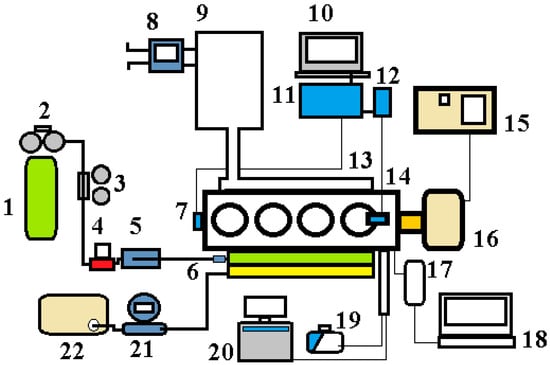
Figure 1.
Hydrogen engine test bench diagram.
The share of hydrogen that substitutes the diesel fuel is determined by the energetic substitution ratio, xE, according to the following relation:
where
ChH2—hydrogen consumption in kg/h;
HiH2—lower heating value of hydrogen in kJ/kWh;
ChDF—diesel fuel consumption in kg/h;
HiDF—lower heating value of diesel fuel in kJ/kWh.
The experimental investigations were carried out at a regime of 2500 rev/min engine speed and a 37% load for different energetic substitution ratios in the area of xE = 0–41.3%, among which the value xE = 0% represents diesel fuelling.
The main components of the experimental test bench presented in Figure 1 are as follows: 1—hydrogen tank, 2—high-pressure reducers, 3—low-pressure reducers, 4—Alicat Scientific MC50 flowmeter for hydrogen (Tucson, AZ, USA), 5—flame arrestor, 6—hydrogen injector, 7—AVL angle encoder 650 CC (Graz, Austria), 8—Krohne inlet air flowmeter (Duisburg, Germany), 9—engine inlet air tank, 10—computer of the data acquisition system, 11—AVL Indimodul 621 data acquisition system (Graz, Austria), 12—AVL piezo-transducer amplifier (Graz, Austria), 13—AVL GU 13P piezoelectric pressure transducer (Graz, Austria), 14—K9K diesel engine, 15—Horiba Schenck control cabinet (Oberursel, Germany), 16—Horiba Schenck E90 dynamometer (Oberursel, Germany), 17—Dastek Unichip electronic control unit (Pretoria, Republic of South Africa), 18—computer of the Dastek Unichip electronic control unit (Pretoria, Republic of South Africa), 19—wireless AVL opacimeter (Graz, Austria), 20—AVL MDS 450 gas analyser (Graz, Austria), 21—Optimass flowmeter for diesel fuel (Duisburg, Germany), and 22—diesel fuel tank.
The experimental instruments were calibrated before starting the experimental session. The accuracy of the measuring devices is presented in Table 1.

Table 1.
The errors of the experimental devices.
For each operating point defined by an xE value, a set of 200 individual data were recorded, presenting interest parameters such as cylinder pressure, angle of peak pressure, pressure rise rate, and heat release. For parameters such as fuel consumption, level of pollutant emissions, greenhouse gases, and temperatures, five datasets were recorded. Based on these, the study of combustion involves the analysis of the heat release rate, the reaction heat release law, the total duration of the combustion process, and also the influence of the energetic substitute ratio value on the level of carbon-based emissions.
The Δi is used to determinate the accuracy of the measurement results for a set of five measurements taken for each operating regime, and its values did not exceed 1%.
The diesel fuel consumption was 4.96 kg/h at xE = 0%, 4.46 kg/h at xE = 8.4%, 3.65 kg/h at xE = 23.5%, and 2.79 kg/h at xE = 41.3%. The hydrogen flow was injected into the inlet manifold by using an electronic injector unit. The electronic injector unit was mounted in the last section of the inlet linie, closer to the inlet valves. Thus, the air–hydrogen mixture was easy to create and was admitted into the cylinder. The diesel fuel was energetically substituted for hydrogen with an energetic percentage of 8.4%, 23.5%, and 41.3%. These values correspond to hydrogen consumption flows of 0.1438 slpm at xE = 8.4%, 0.396 slpm at xE = 23.5%, and 0.689 slpm at xE = 41.3%. The hydrogen concentration in the in-cylinder inlet air is 0.121% for xE = 8.4%, 0.347% for xE = 23.5%, and 0.608% for xE = 41.3%.
For the experimental K9K hydrogen-fuelled engine, there was no overlapping valve opening. The intake valve opening timing was 9 CAD before TDC, and the exhaust valve closing timing was 27 CAD before TDC; these valves did not have a simultaneous opening period.
This aspect represents a novelty of this work and offers the advantage of eliminating hydrogen losses during the overlapping opening of the intake and exhaust valves. Given that the intake and exhaust valves were not opened simultaneously, and there was no cylinder sweep and hydrogen leaks, one can refer to internal exhaust gas recirculation. The hydrogen flow rate used was established to restore engine power when the engine was fuelled with diesel, and it thus compensated for any possible losses of hydrogen to the engine crankcase. The hydrogen leaks were imperceptible, considering that the engine operation was normal, without exhaust misfires. Any hydrogen leaks from the crankcase were taken over by the crankcase ventilation system, which remained unchanged, and the gases were returned to the intake before then returning to the cylinder. When analyzing the exhaust gases, no increases in HC emissions were recorded when hydrogen was also supplied.
The optimal correlation among engine load–engine speed–hydrogen cyclic dose–diesel fuel dose–supercharging pressure–exhaust gas temperature–excess air coefficient while using the investigated regime can be considered a novelty aspect of this research. Another novelty is the use of electronically assisted injection for hydrogen supply compared to the inlet–carburettor supply solution, which is specific to the diesel gas method. Another novelty aspect is that for the experimental diesel engine, there was no overlapping valve opening, and this introduced the advantage of eliminating hydrogen losses during the overlapping opening of the intake and exhaust valves.
3. Study Results and Discussion
Results of the Experimental Study
The in-cylinder pressure diagrams, which were obtained by averaging 200 individual smoothed diagrams, are presented in Figure 2 for different energetic substitute ratios.

Figure 2.
Indicated diagrams of in-cylinder pressure for different energetic substitution ratios of the diesel fuel with hydrogen.
When fuelled with hydrogen and diesel fuel, the pressure in the cylinder changes significantly, the growth slope becoming steeper, and the maximum values increasing. The maximum value tends to approach the Top Dead Centre (TDC), which may correspond to a faster, more brutal combustion in the presence of air–hydrogen mixtures established in the cylinder at the moment of autoignition of the diesel dose. This trend is amplified by the increase in the cyclic hydrogen dose when xE increases. Moreover, it can be observed in an individual cycle that at maximum xE, the pressure oscillations produced by the brutal combustion are amplified, as shown in Figure 2. Similar results were obtained by other researchers [4,6].
At a higher hydrogen fuelling angle, the maximum pressure appears sooner, with a per-cycle rate of 1 CAD at xE = 8.4%, 2 CAD at xE = 23.5%, and 4 CAD at xE = 41.3%. The approach of the maximum pressure angle to the TDC can be correlated with the increase in the share of the premixed phase of combustion for the preformed mixtures produced by hydrogen fuelling.
The value of the maximum pressure increases by 5.98% at xE = 8.4%, by 14.77% at xE = 23.5%, and by 19.11% for xE = 41.3% comparative to xE = 0%, as Figure 3 shows. The higher combustion speed of the air–hydrogen mixtures compared to that of the air–diesel vapor mixtures but with the same excess air coefficient can lead to a reduction in combustion duration, meaning the use of hydrogen increases efficiency.
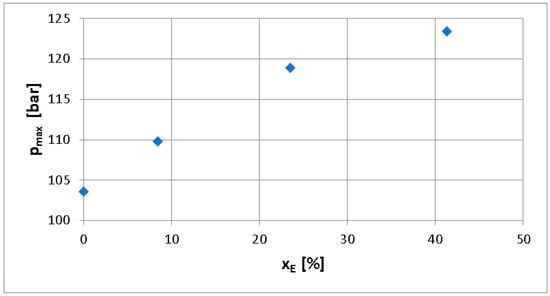
Figure 3.
Maximum pressure for different energetic substitution ratios of the diesel fuel with hydrogen.
Higher hydrogen combustion rates influence the variation in the maximum pressure rise, as shown in Figure 4. When using hydrogen fuelling, the maximum pressure rise rate increases by 6.51% at xE = 8.4%, by 50.93% at xE = 23.5%, and by 23.94% at xE = 41.3%, compared to xE = 0%, as shown in Figure 4. It is noted that there is a correlation between the trends of decreasing maximum pressure angle, increasing maximum pressure, and increasing maximum pressure rise rate. Although the recorded values do not exceed the range of usual values specific to diesel engines, the increasing trend recorded in the maximum pressure values and the pressure increase rate may be a criterion for limiting the cyclic hydrogen dose—at xE = 41.3%—in order to maintain engine reliability. Similar results were obtained by other researchers [5,12].
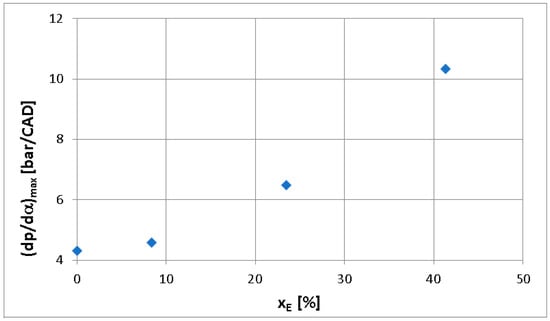
Figure 4.
Maximum pressure rise rate for different energetic substitution ratios of the diesel fuel with hydrogen.
The higher value of the LHV of hydrogen, large inflammability limits, and higher flame speed comparative to diesel fuel lead to an increase in the HRR peak when using hydrogen, as shown Figure 5. For hydrogen fuelling, the peak of the increase in heat release rate was 45.77% at xE = 41.3%. For the energetic substitution ratios xE = 8.4% and xE = 23.5%, similar values were registered, but a tendency to accelerate the combustion process in the presence of hydrogen was observed for all energetic substitution ratios, with the peak of HRR occurring earlier in the cycle, as shown in Figure 5.
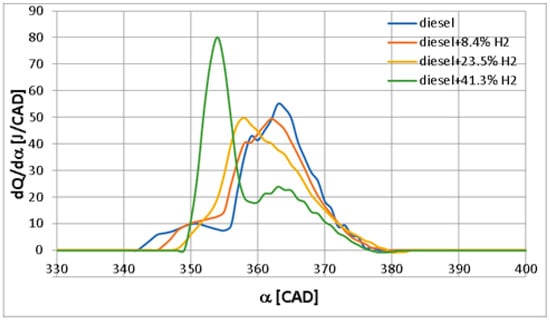
Figure 5.
Heat release rate diagrams for different energetic substitution ratios of the diesel fuel with hydrogen.
The angle at which the maximum value of the heat release rate occurs was reduced to 1 CAD at xE = 8.4%, to 5 CAD at xE = 23.5%, and to 9 CAD at xE = 41.3%. The reduction in the angle of maximum HRR correlates with the reduction in the angle at which the maximum pressure occurs, as shown in Figure 2 and Figure 3. Similar results were obtained by other researchers [5,12].
The heat release law became more aggressive when the hydrogen cyclic dose was at its maximum of xE = 41.3%, and the rapid phase of combustion process increased its share at xE = 41.3%, as shown in Figure 6.
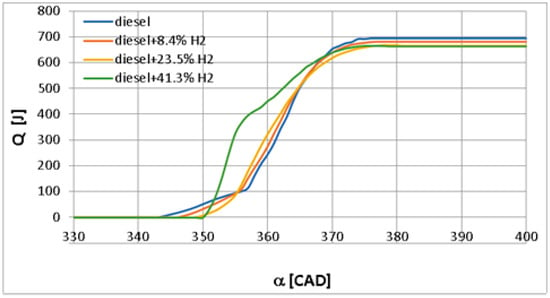
Figure 6.
Heat release law diagrams for different energetic substitution ratios of the diesel fuel with hydrogen.
Due to H2’s higher flame speed and wider inflammability limits, the total duration of combustion was reduced when using hydrogen, as shown in Figure 7. The combustion duration decreased to 2 CAD at xE = 8.4%, to 3 CAD at xE = 23.5%, and to 8 CAD for xE = 41.3% versus classic fuelling, xE = 0%. The duration of the combustion process reduced by 5.7% at xE = 8.4%, by 8.5% at xE = 23.5%, and by 22.8% for xE = 41.3% comparative to diesel fuelling. Reducing the combustion duration led to an increase in maximum pressure and maximum pressure rise rate when using H2, as shown in Figure 3 and Figure 4. Similar results were obtained by other researchers [5].
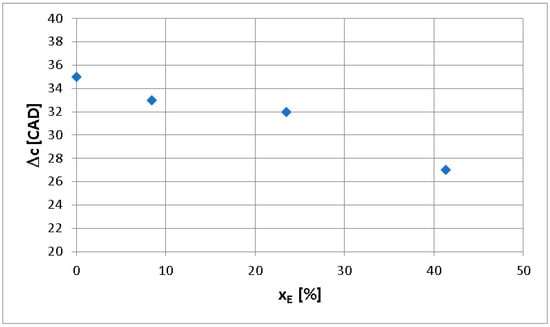
Figure 7.
Total combustion duration for different hydrogen substitution ratios.
However, reducing combustion can positively influence engine efficiency, as shown in Figure 8. When using hydrogen, the reduction in the angle at which the maximum pressure appears per cycle, as shown in Figure 2, demonstrates the approach of the rapid combustion phase to the TDC, which leads to an increase in the share of isochoric combustion, which leads to an increase in thermal efficiency, as shown in Figure 8.
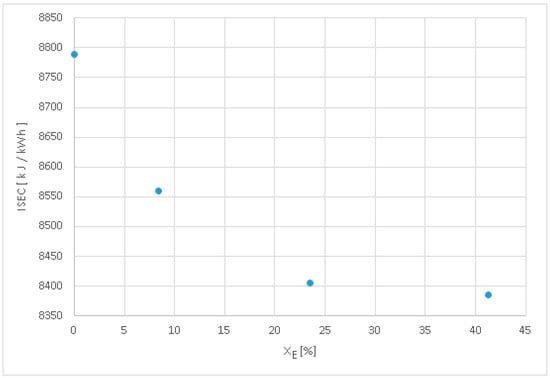
Figure 8.
Indicated specific energy consumption for different energetic substitution ratios of the diesel fuel with hydrogen.
This increase correlates with a tendency to reduce combustion duration, as shown in Figure 7. Thus, when using hydrogen fuelling, the indicated specific energy consumption (ISEC) decreases by 2.58% to xE = 8.4%, by 4.35% at xE = 23.5%, and by 4.58% at xE = 41.3% compared to classic fuelling, xE = 0%. Similar results were obtained by other researchers [7,12].
High-speed combustion of homogeneous air–hydrogen mixtures contributes to reducing HC emission levels.
The HC emission level decreased by 4% at xE = 8.4%, by 14% at xE = 23.5%, and by 18% at xE = 41.3%, as Figure 9 shows. Similar results were obtained by other researchers [5,12,18].
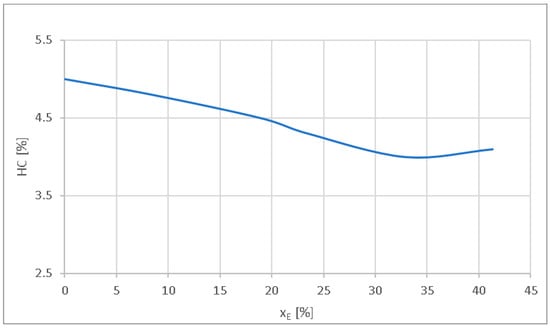
Figure 9.
The HC for different energetic substitution ratios of diesel fuel with hydrogen.
The smoke emission level, assessed by the opacity value of the exhaust gases, was reduced when diesel was replaced with hydrogen, as shown in Figure 10. When using hydrogen, the smoke opacity decreased by 52.02% for xE = 8.4%, by 70.27% for xE = 23.5%, and by 45.27% for xE = 41.3%, as shown in Figure 10. At maximum xE, the reduction in smoke opacity was less pronounced, probably due to the reduction in the amount of air available in the cylinder. Limiting the tendency for smoke emission to increase can be achieved by increasing the boost pressure, which will ensure an increase in the amount of air per cycle. Similar results were obtained by other researchers [4,5,12].
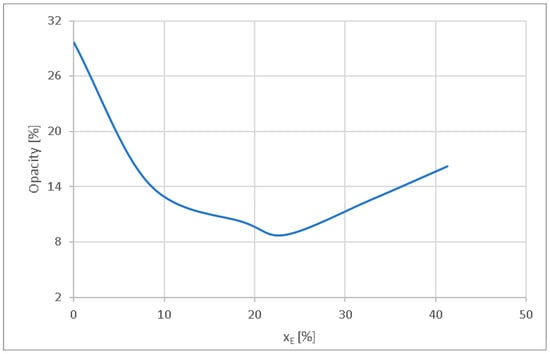
Figure 10.
Smoke opacity for different energetic substitution ratios of the diesel fuel with hydrogen.
The NO emission level’s variation is presented in Figure 11. When using hydrogen fuelling, the level of NO emissions increased due to the increase in cylinder temperature during combustion. For xE = 8.4%, the NO emission level increased by 18.58%. For xE = 23.5% and xE = 41.3%, the NO level increased by 62.82% and 123.71%, respectively. If solutions such as tuning the injection advance, EGR rate modification, or using Ad-Blue are not applied to reduce NO, then in order to limit the increase in the NO level, limiting the energetic substitution ratio xE to 41.3% can be considered. When using hydrogen fuelling, the NO emission level starts to increase because the combustion temperature increases. The engine is equipped with an exhaust gas recirculation system, and a modification of the recirculated gas flow rate could be considered in further research, especially to limit the increase in NO emission levels. Similar results regarding the NOx emission level’s variation were obtained by other researchers [1,2,3,5,12,18,19].
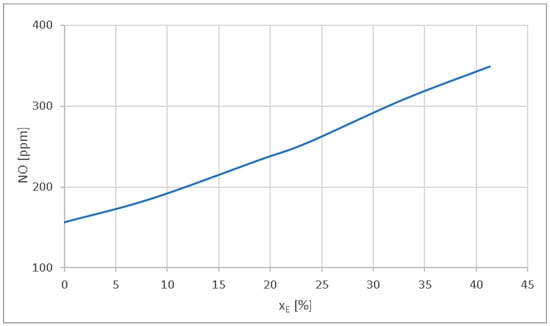
Figure 11.
The NO for different energetic substitution ratios of diesel fuel with hydrogen.
The reduction in the CO2 emission level, as shown in Figure 12, is attributed to the reduction in carbon content, as shown in Figure 13, when replacing diesel fuel with hydrogen.
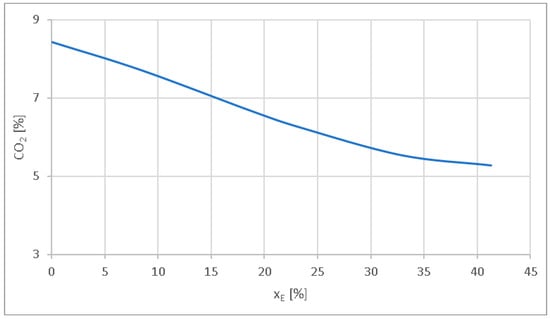
Figure 12.
The CO2 for different energetic substitution ratios of diesel fuel with hydrogen.
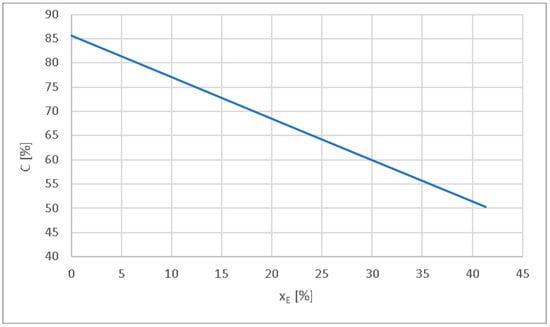
Figure 13.
The carbon content in cylinder mixture for different energetic substitution ratios of diesel fuel with hydrogen.
Compared to diesel fuelling, the CO2 emission level was reduced by 11.13% at xE = 8.4%, by 26% at xE = 23.5%, and by 37.44% at xE = 41.3%. The reduction in the CO2 emission level is related to the reduction in the carbon content when using hydrogen. The in-cylinder mixture contained 85.7% carbon when using diesel fuelling, but for hydrogen use, the carbon content decreased to 78.5% at xE = 8.4%, to 65.5% at xE = 23.5% and to 50.3% at xE = 41.3%, as Figure 13 shows. When using hydrogen, the mixture’s carbon content decreased by 8% for xE = 8.4%, by 23% for xE = 23.5%, and by 41% for xE = 41.3%. Similar results were obtained by other researchers [2,5,12,15].
Regarding the variation in the level of carbon-based emissions with the variation of the quantity of cyclic H2, the reduction in CO2 emissions can be attributed to the reduction in the amount of carbon in the mass composition of the final mixture when replacing diesel fuel with hydrogen. The lower amount of carbon in the composition of the air–H2–diesel fuel vapour mixture compared to diesel fuel actually implies a reduction in the initial amount of carbon available in the cylinder at the beginning of the combustion process, which subsequently leads to lower amounts found in the exhaust gases.
By partially substituting diesel with H2, a 35% reduction in the amount of carbon available for combustion can thus be obtained.
The correspondence of the reduction in the initial carbon percentage with the increase in the H2 dose can be observed in the variation in CO2 emissions. Thus, at low substitution degrees up to 41.3%, the CO2 emission was reduced by 37% compared to diesel fuel use.
The reduction in HC and smoke is attributed to the high-speed combustion of homogeneous air–H2 mixtures, which ensure a reduction in HC emissions when their proportion in the cylinder increases. Reducing the diesel fuel dose and carbon content allows for a reduction in the amount of soot formed, and the presence of H2 in the air–diesel fuel vapour mixture leads to the acceleration of the oxidation of the soot formed. However, for xE > 20%, HC and smoke begin to increase slightly as a result of the reduction in the amount of oxygen, which itself is a result of a reduction in the amount of air available in the cylinder when the dose of H2 in the intake air increases. In future studies, corrections can be made by increasing the amount of air by increasing the boost pressure when using higher cyclic doses of H2.
The level of CO2 emissions is influenced to a greater extent by the carbon content of the mixture in the cylinder, which is reduced when using H2, and the emissions of HC and smoke are more strongly influenced by the reduction in the O2 content, as an oxidant, because they are more sensitive to the reduction in the amount of air necessary for combustion when the dose of H2 is increased. The level of CO2 emission is also influenced by the energetic performance of the engine cycle, which increases when using H2; the level of CO2 emission decreases, and the influence of the dose of H2 on the energetic performance of the cycle is stronger than the influence of the reduction in available oxygen.
The results derived from this research are intended to inform the development of optimized dual-fuel strategies that effectively balance performance improvements with environmental considerations for the investigated operating regime. In order to maintain power performance at 37% load and 2500 rev/min and to maintain the advantages of improved engine efficiency and reduced exhaust emissions, the dual-fuel strategy—which effectively balances performance improvements with environmental considerations—involved limiting the energetic substitution ratio to 41.3%.
Optimal dual-fuel strategies that effectively balance performance improvements with environmental considerations require limiting the energetic substitution ratio to a value of 23.5%. At this setting, the increasing trend of smoke emissions is limited, and the significant reduction of 70.27% in smoke emissions is maintained by limiting the hydrogen flow rate to 0.396 slpm. In these settings, with dual fuelling, an energy consumption level of 8405 kJ/kW h can be obtained, which is 4.35% lower than for diesel fuelling. With this limitation, the HC emission level is reduced by 14%.
The maximum pressure can be limited to an increase of 14.7%, without exceeding values of 120 bar, which brings advantages in terms of reliability and combustion noise during operation. The combustion noise can be limited to a percentage increase of 50.93%; thus, the value of the maximum pressure rise rate can be limited to 6.5 bar/CAD. With these settings, the heat release rate would not be significantly affected, and the combustion duration would be reduced by 8.5%, by 2 CAD.
For these settings, the tendency of the NOx emission level to increase would be limited, but AdBlue technology can be used to decrease the NOx emission level. With these settings, the emission of greenhouse gas, CO2, would be reduced by 26% compared to classic fuel use.
4. Conclusions
The use of hydrogen to substitute diesel fuel has the following effects.
- -
- The carbon content of the in-cylinder mixture decreases to 78.5% at xE = 8.4%, to 65.5% at xE = 23.5% and to 50.3% at xE = 41.3%, from 85.7% carbon with diesel fuelling. When using hydrogen, the mixture’s carbon content decreases by 8% for xE = 8.4%, by 23% for xE = 23.5%, and by 41% for xE = 41.3%.
- -
- The CO2 emission level is reduced by 11.13% at xE = 8.4%, by 26% at xE = 23.5%, and by 37.44% at xE = 41.3%. The reduction in the CO2 emission level is related to the reduction in the carbon content when using hydrogen.
- -
- The HC emission level decreases by 4% at xE = 8.4%, by 14% at xE = 23.5%, and by 18% at xE = 41.3%, due to high-speed combustion of homogeneous air–hydrogen mixtures.
- -
- Due to a reduction in the carbon content, the smoke emission level, which is assessed by the opacity value of the exhaust gases, decreases by 52.02% for xE = 8.4%, by 70.27% for xE = 23.5%, and by 45.27% for xE = 41.3%. At maximum xE, the reduction in smoke opacity is less pronounced, probably due to the reduction in the amount of air available in the cylinder. Limiting the tendency for smoke emissions to increase can be achieved by increasing the boost pressure, which will ensure an increase in the amount of air per cycle.
- -
- The NO emission level increases because of temperature rise during combustion. For xE = 8.4%, the NO emission level increases by 18.58%. For xE = 23.5% and xE = 41.3%, the NO level increases by 62.82% and 123.71%, respectively. If solutions such as tuning the injection advance, EGR rate modification, or using Ad-Blue are not applied to reduce NO, then in order to limit the increase in the NO level, limiting the energetic substitution ratio xE to 41.3% can be considered.
The reduction of the carbon content, CO2, HC, and smoke opacity can be assured in by the following factors.
- -
- In-cylinder pressure increases to a maximum value which tends to approach the TDC, which may correspond to faster, more brutal combustion in the presence of air–hydrogen mixtures established in the cylinder at the moment of autoignition of the diesel dose. This trend is amplified by the increase in the cyclic hydrogen dose, when xE increases. In some individual combustion cycles, it can be observed that at maximum xE = 41.3%, the pressure oscillations produced by the brutal combustion are amplified.
- -
- The angle of maximum pressure appears sooner per cycle, with 1 CAD at xE = 8.4%, with 2 CAD at xE = 23.5%, and with 4 CAD at xE = 41.3%. The approach of the maximum pressure angle to the TDC can be correlated with the increase in the share of the premixed phase of combustion among the preformed mixtures involved in hydrogen fuelling.
- -
- The value of maximum pressure increases by 5.98% at xE = 8.4%, by 14.77% at xE = 23.5%, and by 19.11% for xE = 41.3% compared to xE = 0%. The higher combustion speed of air–hydrogen mixtures compared to that of air–diesel vapor mixtures at the same excess air coefficient can lead to a reduction in the duration of combustion, meaning that the use of hydrogen has an increasing influence on efficiency.
- -
- The maximum pressure rise rate increases by 6.51% at xE = 8.4%, by 50.93% at xE = 23.5%, and by 23.94% at xE = 41.3%, compared to xE = 0%. There is a correlation between the trends of decrease in the maximum pressure angle, increase in the maximum pressure, and increase in the maximum pressure rise rate. Although the recorded values do not exceed the range of usual values specific to diesel engines, the increasing trend recorded in the maximum pressure values and the pressure increase rate may be a criterion for limiting the cyclic hydrogen dose to xE = 41.3% in order to maintain engine reliability.
- -
- The peak of the increase in heat release rate was 45.77% at xE = 41.3%. For the energetic substitution ratios xE = 8.4% and xE = 23.5%, similar values were registered, but a tendency to accelerate the combustion process in the presence of hydrogen was observed for all energetic substitution ratios, with the peak of HRR occurring earlier in the cycle due to the higher value of the LHV of hydrogen, large inflammability limits, and a higher flame speed comparative to diesel fuel.
- -
- The angle at which the maximum value of the HRR occurs was reduced by 1 CAD at xE = 8.4%, by 5 CAD at xE = 23.5%, and by 9 CAD at xE = 41.3%. The reduction in the angle of maximum HRR correlates with the reduction in the angle at which the maximum pressure occurs.
- -
- The heat release law becomes more aggressive when the hydrogen cyclic dose is at its maximum, at xE = 41.3%, and the rapid phase of the combustion process increases its share at this value of xE = 41.3%.
- -
- The total duration of combustion is reduced when using hydrogen due to H2’s higher flame speed and wider inflammability limits. The combustion duration decreases by 2 CAD at xE = 8.4%, by 3 CAD at xE = 23.5%, and by 8 CAD for xE = 41.3% versus classic fuelling, xE = 0%. The combustion process reduces its duration by 5.7% at xE = 8.4%, by 8.5% at xE = 23.5%, and by 22.8% for xE = 41.3% compared to diesel fuelling. Reducing the duration of combustion leads to an increase in maximum pressure and maximum pressure rise rate when using H2; when using hydrogen, the reduction in the angle at which the maximum pressure appears per cycle indicates the approach of the rapid combustion phase to the TDC, which leads to an increase in the share of isochoric combustion, which itself leads to an increase in thermal efficiency. This increase correlates with the tendency to reduce the duration of combustion.
- -
- The indicated specific energy consumption decreases by 2.58% to xE = 8.4%, by 4.35% at xE = 23.5%, and by 4.58% at xE = 41.3% compared to classic fuelling, xE = 0%.
Author Contributions
Conceptualization, A.P., A.C., C.P., N.N. and C.N.; methodology, C.P., N.N., A.C., A.P., D.F., L.N. and C.N.; software, A.C., C.P., N.N., D.F., L.N. and C.N.; validation, A.C., C.P., N.N. and C.N.; formal analysis, A.C., C.P., N.N., C.N., L.N. and A.P.; investigation, A.C., C.P., N.N., D.F., C.N., L.N. and A.P.; resources, A.C., C.P., N.N., D.F., L.N. and C.N.; data curation, A.C., C.P., N.N., L.N. and C.N.; writing—original draft preparation, A.P., A.C., C.P., N.N. and C.N.; writing—review and editing, A.P., A.C., C.P., N.N., C.N.; visualization, A.C., C.P., N.N., D.F., C.N., L.N. and A.P.; supervision, C.P., N.N., C.N. and A.C.; project administration, C.P., N.N., A.C. and C.N.; funding acquisition, C.P., N.N., A.C., D.F., L.N. and C.N. All authors have read and agreed to the published version of the manuscript.
Funding
This work was supported by a grant from the Ministry of Research, Innovation and Digitization, CCCDI-UEFISCDI, project number PN-III-P2-2.1-PED-2021-0427, within PNCDI III. This work was supported by a grant from the National Program for Research of the National Association of Technical Universities—GNAC ARUT 2023. This work was supported by Maximizing the Renewable Energy Hosting Capacity of Distribution Networks, MAREHC, Investiția 8 “Dezvoltarea unui program pentru atragerea resurselor umane înalt specializate din străinătate în activități de cercetare, dezvoltare și inovare”, PNRR-III-C9-2022–I8, Componenta: C9 Suport pentru sectorul privat, cercetare, dezvoltare și inovare.
Institutional Review Board Statement
Not applicable.
Informed Consent Statement
Not applicable.
Data Availability Statement
The original contributions presented in this study are included in the article. Further inquiries can be directed to the corresponding author.
Acknowledgments
The authors address special thanks to AVL GmbH Graz Austria for providing the necessary equipment.
Conflicts of Interest
The authors declare no conflicts of interest.
Abbreviations
| AVL | Anstalt für Verbrennungskraftmaschinen List automotive research institute Graz Austria |
| BTE | Brake Thermal efficiencyEfficiency (or ηe) |
| BTDC | Before Top Dead Centre |
| BSFC | Brake-Specific Fuel Consumption |
| BSEC | Brake-Specific Energetic Consumption |
| CFR | Cooperative Fuel Research |
| CAD | Crank Angle Degree (or °CA) |
| Ch | Hourly Fuel Consumption |
| CO | Carbon Monoxide |
| CO2 | Carbon Dioxide |
| DI | Direct Injection |
| DME | Dimethyl Ether |
| EU | European Union |
| ECU | Engine Control Unit |
| EGR | Exhaust Gas Recirculation |
| G | Gasoline |
| H2 | Hydrogen |
| HC | Unburned Hydrocarbon |
| Hi | Lower Heating Value |
| HRR | Heat Release Rate |
| ICE | Internal Combustion Engine |
| IMEP | Indicate Mean Effective Pressure |
| J | Joule |
| K | Kelvin |
| L | Liter |
| LHV | Lower Heating Value |
| LPG | Liquid Petroleum Gas |
| lpm | Liter Per Minute |
| MTB | Maximum Torque Brake |
| m | Kinetic Parameter |
| m/s | Meter/Second |
| NOx | Nitrogen Oxides (Or NO) |
| PFI | Port Fuel Injection |
| pmax | Maximum Pressure |
| p | In-Cylinder Pressure |
| rpm | Revolutions Per Minute (Or Rev/Min) |
| SIE | Spark Ignition Engine (Or SI Engine) |
| SCR | Selective Catalytic Reduction |
| slpm | Standard Litre Per Minute |
| TDC | Top Dead Centre |
| T | In-Cylinder Temperature |
| λ | Coefficient Of Excess Air |
| xE | Energetic Substitution Ratio |
References
- Liu, X.; Seberry, G.; Kook, S.; Chan, Q.N.; Hawkes, E.R. Direct Injection of Hydrogen Main Fuel and Diesel Pilot Fuel in a Retrofitted Single-Cylinder Compression Ignition Engine. Int. J. Hydrogen Energy 2022, 47, 35864–35876. [Google Scholar] [CrossRef]
- Wright, M.; Lewis, A.C. Decarbonization of Heavy-Duty Diesel Engines Using Hydrogen Fuel: A Review of the Potential Impact on NOx Emissions. Environ. Sci. Atmos. 2022, 2, 852–866. [Google Scholar] [CrossRef]
- Akhtar, M.U.S.; Asfand, F.; Imran Khan, M.; Mishra, R.; Ball, A.D. Performance and Emission Characteristics of Hydrogen–Diesel Dual-Fuel Combustion for Heavy-Duty Engines. Int. J. Hydrogen Energy 2025, 143, 454–467. [Google Scholar] [CrossRef]
- Mukhtar, G.A.; Tange, K.; Nakatani, S.; Horibe, N.; Kawanabe, H.; Morita, G.; Hiraoka, K.; Koda, K. Performance and Emissions of a Hydrogen Dual-Fuel Engine Using Diesel and HVO as Pilot Fuels; SAE Technical Paper 2024-01-4286; SAE: Warrendale, PA, USA, 2024. [Google Scholar]
- Zhang, B.; Wang, H.; Wang, S. Computational Investigation of Combustion, Performance, and Emissions of a Diesel-Hydrogen Dual-Fuel Engine. Sustainability 2023, 15, 3610. [Google Scholar] [CrossRef]
- Alzohbi, G. An Overview of Hydrogen Energy Generation. ChemEngineering 2004, 8, 17. [Google Scholar] [CrossRef]
- Badea, N.I. Hydrogen as Energy Sources-Basic Concepts. Energies 2021, 14, 5783. [Google Scholar] [CrossRef]
- Han, W.; Dai, P.; Gou, X.; Chen, Z. A Review of Laminar Flame Speed of Hydrogen and Syngas Measured from Propagating Spherical Flames. Appl. Energy Combust. Sci. 2020, 1, 100008. [Google Scholar] [CrossRef]
- Levikhin, A.A.; Boryaev, A.A. Physical Properties and Thermodynamic Characteristics of Hydrogen. Heliyon 2024, 10, e36414. [Google Scholar] [CrossRef] [PubMed]
- Mekonnin, A.S.; Waclawiak, K.; Humayum, M.; Zhang, S.; Ullah, H. Hydrogen Storage Technology, and Its Challenges: A Review. Catalysts 2025, 15, 260. [Google Scholar] [CrossRef]
- Mohamed, M.; Longo, K.; Zhao, H.; Hall, J.; Hamington, A. Hydrogen Engine Insights: A Comprehensive Experimental Examination of Port Fuel Injection and Direct Injection; SAE Technical Papers 2024-01-2611; SAE: Warrendale, PA, USA, 2024; pp. 1–16. [Google Scholar]
- Barik, D.; Bora, B.J.; Shanma, P.; Medhi, B.J.; Balasubramanian, D.; Krupakaran, R.L.; Ramegowda, R.; Kavalli, K.; Femilda Josephin, J.S.; Vikneswaran, M.; et al. Exploration of the Dual Fuel Combustion Mode on a Direct Injection Diesel Engine Powered with Hydrogen as gaseous Fuel in Port Injection and Diesel–Diethyl Ether Blend as Liquid Fuel. Int. J. Hydrogen Energy 2024, 52 Pt B, 827–840. [Google Scholar] [CrossRef]
- Mohamed, M.A.; Wang, X.; Zhao, H. Hydrogen Crankcase Slip Phenomena: Experimental Study of Forced Ventilation Effects on Hydrogen Engine Performance and Emissions. SAE Int. J. Engine 2025, 18, 611–628. [Google Scholar] [CrossRef]
- Kumar, A.; Kumar, C.B.; Lata, D.B. Effect of hydrogen enrichment on exhaust gas temperature and emission of a dual fuel diesel engine. Mater. Today Proc. 2023, 72, 631–635. [Google Scholar] [CrossRef]
- Armbrustr, F.; Zepf, A.; Prager, M.; Hartl, M.; Jaensch, M. Fuel slip in hydrogen-powered port-fuel-injected large- bored stationary engines under stable operation and in the presence of combustion anomalies. Int. J. Hydrogen Energy 2025, 173, 151195. [Google Scholar] [CrossRef]
- Mohamed, M. Unveiling the Potential of Hydrogen in a Downsized Gasoline Direct Injection Engine Performance and Emissions Experimental Study. SAE Int. J. Fuel Lubr. 2024, 17, 225–242. [Google Scholar] [CrossRef]
- Zambelli, C. Exhaust System for Hydrogen Fuelled Combustion Engines: Effect of High-Water Content on the SCR Vanadium Catalyst. Master’s Thesis, KTH Royal Institute of Technology, Stocholm, Sweden, 2023; pp. 1–55. [Google Scholar]
- Mohamed, M.; Wang, X.; Zhao, H.; Peckham, M.; Hall, J.; Jiag, C. A Comprehensive Experimental Investigation of NOx Emission Characteristics in Hydrogen Engine Using an Ultra-Fast Crank Domain Measurement. Energies 2024, 17, 4141. [Google Scholar] [CrossRef]
- Heywood, J.B. Internal Combustion Engine Fundamentals; McGraw-Hill, Inc.: New York, NY, USA, 1988; ISBN 0-07-028637-X. [Google Scholar]
Disclaimer/Publisher’s Note: The statements, opinions and data contained in all publications are solely those of the individual author(s) and contributor(s) and not of MDPI and/or the editor(s). MDPI and/or the editor(s) disclaim responsibility for any injury to people or property resulting from any ideas, methods, instructions or products referred to in the content. |
© 2025 by the authors. Licensee MDPI, Basel, Switzerland. This article is an open access article distributed under the terms and conditions of the Creative Commons Attribution (CC BY) license (https://creativecommons.org/licenses/by/4.0/).